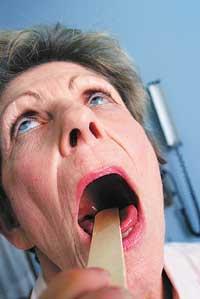Cut mouth
Having a dry mouth is not pleasant and unless that dryness becomes a disease. However, there is more than one disease related to the lack of txistu, such as sicca-sicca and Gougerot-Sjögren syndrome.
Research on these rare diseases began to strengthen in 1976 with knowledge of the new functions of the ATP molecule (adenine triphosphate). In that year, ATP and its derivatives saw control of several biological processes and the result began to investigate in Leioa its relationship with whistling.
These investigations undoubtedly had a biological and medical interest, for example, to cure the above-mentioned diseases. In fact, these diseases that appear in elderly people cause the lack of txistu and tears.

Goujerot-Sjögren's syndrome is more tolerated by women than by men, 10% more.
It should be noted that the absence of txistus and tears is a serious problem, since without txistu dry mouth appears, difficulty speaking and swallowing food and, if the tear is insufficient, can even become blind.
The importance of txistu
Txistu protects and cleans the mouth, digestive tract, and stomach. There are proteins and other important enzymes, as well as ESF (Epidermal Growth Factor proteins). EGF proteins promote the growth of the skin and constantly resolve the wounds produced by food in the mouth and digestive tract.
Given the importance of txistu, studies focused primarily on the glands that segregated txistu, as is the case with the gland located under the maxilla. These glands, with Goujerot-Sjögren's syndrome, express a protein. This protein contributes to the proliferation of T lymphocytes around the gland, being surrounded by antibodies and proteins. Goujerot-Sjögren's syndrome is an autoimmune disease.
In fact, the study of these glands showed that the ATP molecule and its receptors (purinergic receptors) exerted a great influence on whistling. ATP occurs when txistu glands are excited, i.e. when we eat or at the beginning of digestion.
In view of this, the researchers first characterized the ATP receptors present in the cells and then determined their internal mechanisms. Thus, it was observed that in diseases involving a lack of txistu, ATP is sufficient to open the tubes that release txistu. The same would occur in the eye, when tears are missing, or when trachea cleansing fluids are missing, even in patients with colmatate bronchi or cystic fibrosis. For example, ATP also positively influences the prevention of thrombosis in plaques.
Therefore, ATP and its derivatives, by favoring fluid fluidity, are an alternative way for the development of medicines for these diseases. The new functions of the molecule that few researched can be the cure of many patients.
- Project title Characterization of purinergic receptors in txistu glands.
- Objective To investigate the physiology and regulation of pathological processes related to the altered leakage of txistu.
- Principal Investigator Aida Marino.
- UPV Template: A. Marine, E. Alzola, M. García. J. Burzaco, M. Fernandez, M. Count, M. Villate.Free University of Brussels: Jean Paul Dehaye.
- Department of Biochemistry and Molecular Biology.
- •
- • Basque Government, UPV, MCyT, Gangoiti-Barrera Foundation, NATO.
Buletina
Bidali zure helbide elektronikoa eta jaso asteroko buletina zure sarrera-ontzian











